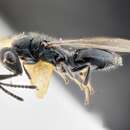Comprehensive Description
provided by Smithsonian Contributions to Zoology
Spalangia nigra Latreille
Spalangia muscae Girault.—Howard, 1911, p. 90.
Spalangia muscae has been thought to be a nomen nudum, a manuscript name, and a described species. Bouček (1963) considered it a nomen nudum; Richardson (1913) and Girault (1920) treated it as a manuscript name; while Bishopp (1913) and Riihl (1916) listed it as a valid, described species. Crawford (in Richardson 1913) took a decided position that muscae was a valid species and Peck (1951, 1963) listed it twice as a valid species.
Howard (1911), in discussing a parasite that had emerged from a puparium of Musca domestica when it was opened by a laboratory worker, made the following statement:
a fully formed and active adult black Spalangia crawled immediately from the opening made by his dissecting needle. This will be described by Girault as Spalangia muscae. A certain proportion of the housefly puparia are affected by this parasite in precisely the same way as are the puparia in Europe by Spalangia nigra as described by Bouché.
Girault never published a description of muscae, and it is extremely doubtful that the passage quoted from Howard can stand by itself as the description of a species. Howard himself evidently did not consider that he had described the species, because he did not designate a type specimen. In 1923, however, S. A. Rohwer located the specimen of Spalangia that Howard had discussed in his book and designated it as Howard's type. Rohwer assigned to it USNM Type No. 26329 and labeled it: “Spalangia muscae How. Type, labeled by Rohwer.”
As was pointed out by Bouček (1963, p. 447), muscae, whatever its standing, is the same as the holarctic species nigra Latreille, 1805.
- bibliographic citation
- Burks, B. D. 1969. "Species of Spalangia Latreille in the United States National Museum collection (Hymenoptera: Pteromalidae)." Smithsonian Contributions to Zoology. 1-7. https://doi.org/10.5479/si.00810282.2
Comprehensive Description
provided by Smithsonian Contributions to Zoology
Spalangia nigra Latreille
Spalangia rugosicollis Ashmead, 1894, p. 36 [female].
This species was described from one female specimen, The type is labeled: “Mo., Spalangia rugosicollis Ashm., Type No. 2168 U.S.N.M.” The pedicel and flagellum of each antenna and the right forewing are missing; otherwise the type specimen is intact.
This type agrees in all diagnostic characters with European specimens in the USNM of Spalangia nigra Latreille, the species with which rugosicollis has been synonymized by Bouček (1963, p. 446). Antennal scape with longitudinal aciculations on inner face; head and pronotum with umbilicate punctation and smooth interstices; pronotum without anterior carina but with isolated crossline of punctures just anterior to posterior margin; pronotum with a smooth, median triangle at posterior margin; scutellum with complete frenal crossrow of punctures; petiole twice as long as broad, with strong longitudinal rugae; gaster no wider than thorax.
- bibliographic citation
- Burks, B. D. 1969. "Species of Spalangia Latreille in the United States National Museum collection (Hymenoptera: Pteromalidae)." Smithsonian Contributions to Zoology. 1-7. https://doi.org/10.5479/si.00810282.2

